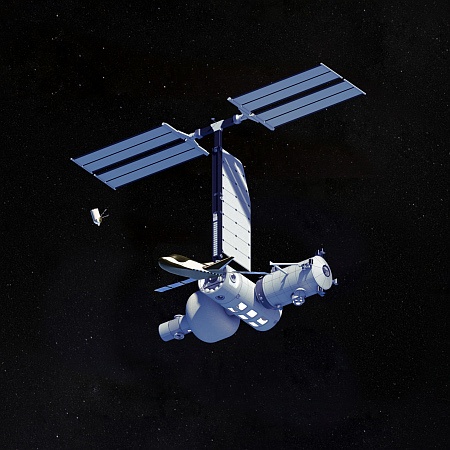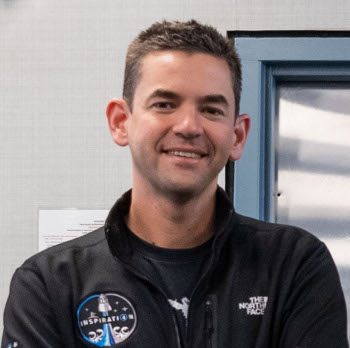Griggs Farms – How A Cotton Picker Works
An evening pause: Technology that makes it possible for humans to live better lives.
Hat tip Judd Clark, who adds “Ten acres/hour, doing the work of 250 or more hand pickers.”
Enjoy your weekend!
An evening pause: Technology that makes it possible for humans to live better lives.
Hat tip Judd Clark, who adds “Ten acres/hour, doing the work of 250 or more hand pickers.”
Enjoy your weekend!

Capitalism in space: In another indication that India’s governments are going full bore for private enterprise in space, two different Indian states this week announced new space policies designed to attract private investment and space startups.
Those two states, Tamil Nadu and Gujarat, are shown on the map to the right. Tamil Nadu announced its new space industrial policy hopes to attract more than a billion dollars in space companies to the state. Gujaret in turn announced its own space policy aimed at attracting $5 billion in investment and 25,000 jobs over the next five years.
It is not surprising that Tamil Nadu has issued this policy, considering that it is the state where India’s new second spaceport, Kulasekarapattinam, is located, and is being built as a launch site for commerical operations. Gujaret is at first glance less obvious, but it houses a major facility of India’s space agency ISRO. It is also one of India’s most industrialized states.
Both however illustrate the impact of the Modi government because of its policy to encourage private enterprise and de-emphasize government control. Not only is the federal government pushing capitalism, the country’s individual states are joining in.
My regular readers will know that I consider NASA’s Aerospace Safety Advisory Panel (ASAP) to be less than useless, repeatedly showing strong biases that allow it to miss major safety issues while causing headaches where no safety problems exist. Those biases consistently favor NASA and the older big space companies while attacking the new space companies like SpaceX.
This week the panel held its quarterly public meeting, and illustrated their uselessness and bias once again. Suddenly they have noticed that ISS has a serious chronic air leak problem due to the stress fractures in the Russian Zvezda module. They also came to the brilliant discovery that ISS is big, and that its de-orbit will have to be done carefully.
Oh my! Will wonders never cease!? These facts have only been documented at length and frequently by numerous inspector general reports and NASA updates over the past half decade. NASA has in fact contracted SpaceX to build a specialized de-orbit spacecraft, larger than a Dragon capsule, to dock with the station and conduct the de-orbit.
NASA didn’t need this safety panel to tell it the obvious.
Meanwhile, the panel suddenly decided it must chime in on budget issues and the possibility of there being major cuts at NASA, something that is entirely outside its area of responsibility. And to no one’s surprise it announced that budget cuts are bad!
Nor did the panelists see any safety issues with putting astronauts in an Orion capsule and flying them around the Moon on the next Artemis launch, even though NASA and its inspector general have both determined that the capsule’s heat shield is unreliable. The panel also had no problem with flying humans in this capsule the very first time its environmental system is tested.
To these political hacks, they see “we see no showstoppers at this time” for this SLS/Orion manned mission.
Instead, as always, the panel focused its criticism and concerns on SpaceX and Starship, labeling its development “the biggest risk” in NASA’s program to get Americans back to the Moon.
The most hilarious aspect of the panelists’ public comments is that they had nothing to say about Boeing’s Starliner, a pattern the panel has followed since Boeing and SpaceX got contracts a decade ago to transport astronauts to and from ISS. Consistently the panel has seen phantom safety risks with SpaceX — where none existed — while ignoring or completely missing Boeing myriad failures. That pattern continues.
NASA does face budget cuts. It would certainly help the agency if every dime wasted on this panel could be funneled into more useful purposes.
As a historian I often bring to any discussion of modern politics and our American space effort a perspective that is very alien to modern Americans. I see things as they once were in the United States back before we had a big overbearing federal government that everyone looked to for leadership. Instead, I see the possibilities inherent in a free nation led by the people themselves, not the government, as America was for its first two centuries.
This sadly is not how America functions today, and it is for that reason that as a nation we can no longer get great things accomplished routinely, as we once did.

Norwegian Amundsen, first to reach the south pole.
To understand how different the American mindset once was, consider just one example, the 19th century effort by numerous nations and individuals to plant their flag at both the north and south poles. While a handful of private American citizens mounted their own expeditions to reach the north pole, none attempted to do so in Antarctica. At both poles the bulk of the effort was done by other nations, sometimes on expeditions privately funded, and sometimes by expeditions with extensive government aid.
In the U.S. however there was no government program to compete in this race. Nor was their the slightest desire by Americans to create one. The attitude of Americans then was very straightforward. They found the race to get to the poles exciting and fascinating, and thoroughly supported the efforts of the explorers both intellectually and emotionally. They however had no interest in their government committing one dime of their tax dollars on its own campaign.
You see, they did not feel a need to establish American prestige in this manner. So what other nations got to the poles first? What mattered to Americans then was what each American wanted to do, and what Americans wanted to do in the 19th century was to settle the west and build their nation into a prosperous place to raise their children.
And so, the south pole was first reached by a Norwegian, followed mere weeks later by an Englishman. Americans played no major role in that early exploration. Nor did it harm America’s prestige in the slightest that it did not compete there. The nation was growing in wealth and prosperity, its citizens were completely free in all ways to follow their dreams, and everyone worldwide knew it.
America might not be the leader in far-flung exploration, but the world knew it was the leader in something as important if not more so, the idea that a nation and a government could be built on the premise that the citizen is sovereign, and that all law should be based on making that citizen’s life, liberty and the pursuit of happiness primary in all things.
And in the end, it did not really matter that the U.S. did not compete in that race to the poles. » Read more

The Middle East, showing the location of
Oman’s proposed spaceport at Duqm.
Oman yesterday announced that it has added a viewing area so that the public can view the planned half dozen launches that are presently planned for the rest of 2025 at its new spaceport in Duqm.
A three-day fan experience in the free-of-charge zone, called Etlaq FX, will feature a series of activities for different age groups, including a robotics competition.
“It is an interactive area within the spaceport, so we can give the public an opportunity to see the launch and engage them with educational activities,” said Zainab Alsalhi, business development manager for Etlaq, during a webinar this month.
The announced launch schedule is of course the real story, as it involves five launches from two different commercial companies as well as from Kuwait.
» Read more
Northrop Grumman yesterday successfully launched a National Reconnaissance Office surveillance satellite, its Minotaur-4 rocket lifting off from Vandenberg in California.
This was the company’s first launch since 2023. Northrop Grumman’s Antares rocket has been out of commission since the company used up its Ukrainian-built first stages, waiting for Firefly to complete its replacement. The repurposed Minotaur-4 missile does not have the capability to replace it.
The leader board for the 2025 launch race remains unchanged:
43 SpaceX
19 China
5 Rocket Lab
5 Russia
SpaceX still leads the rest of the world in successful launches, 43 to 33.
The government of the Bahamas has suspended any further Falcon 9 1st stage landings within its territorial waters until SpaceX completes and submits a full environmental report that proves the one previous drone ship landing in February caused no environmental changes at all.
This quote from the article explains everything:
Addressing calls from environmentalists for an EIA, Mr Dontchev [SpaceX’s vice president of launch] said officials heard their feedback. He added that SpaceX hopes to complete the EIA by the end of summer and resume landings thereafter.
The economic impact of space tourism in The Bahamas has also come into focus. [Deputy Prime Minister Chester] Cooper said the February landing could have sparked a greater interest among students inspiring them to pursue STEM studies. SpaceX also announced its $1m donation to the University of The Bahamas in support of STEM education. [emphasis mine]
First, anti-Musk activists, using the environment as a ploy, made enough noise that the Bahamas government felt forced to bow to them. Second, SpaceX is making sure that government will bow more to it by contributing a lot money to its government educational programs.
Expect more landings soon, as SpaceX predicts.

Screen capture from video of test failure in August 2024.
Note the flame shooting out sideways.
In a major managerial shake-up as it preps for its first launch attempt later this year, the German rocket startup Rocket Factory Augsburg has replaced its CEO, switching from someone with more general business experience to a CEO with a lot of direct experience in the space industry itself.
In an April 11 statement not widely publicized by the company, RFA announced that Stefan Tweraser, who had been chief executive since October 2021, had been replaced by Indulis Kalnins.
The announcement did not give a reason for the change, but it suggested that the company was seeking someone with expertise in the aerospace industry to lead the company. Kalnins is on the aerospace faculty of a German university, Hochschule Bremen, and has been managing director of OHB Cosmos, which focused on launch services.
…Tweraser, by contrast, came from outside the space industry. He joined RFA after past work that included being a consultant at McKinsey & Company, country director for the DACH (Germany, Austria and Switzerland) region at Google and executive at music streaming company Deezer. [emphasis mine]
The highlighted phrase provides I think the explanation for the change. The company had hoped to launch last year, but had a major failure during a static fire engine test on the launchpad, destroying the rocket first stage. The company has probably decided it needed someone in charge who had some hands-on experience with launchpad operations.

Artist rendering of Orbital Reef design, as of
April 2025. Click for original image.
According to a NASA press release today, Blue Origin has successfully completed a ” human-in-the-loop test” in a ground mock-up of the commercial Orbital Reef space station.
The human-in-the-loop test scenarios utilized individual participants or small groups to perform day-in-the-life walkthroughs in life-sized mockups of major station components. Participants provided feedback while simulating microgravity operations, including cargo transfer, trash transfer, stowage, and worksite assessments.
…The milestone is part of a NASA Space Act Agreement originally awarded to Blue Origin in 2021 and focused on the design progress for multiple worksites, floors, and translation paths within the station. This ensures a commercial station can support human life, which is critical to advancing scientific research in a microgravity environment and maintaining a continuous human presence in low Earth orbit.
Though this test might be providing useful information, it leaves me cold. While Blue Origin’s partner in this project, Sierra Space, has been testing real hardware for its LIFE inflatable module (as seen on the left side of the artist’s rendering above), Blue Origin itself appears to have built nothing real. Instead, it is following the old big space paradigm of companies like Boeing that invest none of its own money in development. Instead, the company uses NASA’s development money solely for PR mockups, in the hope the PR will convince NASA to give it the full contract, worth billions. Only then will the real work begin.
Boeing did this with Starliner, and we can all see now how well that turned out.
It also appears that the overall scale of Orbital Reef has been reduced significantly when comparing the current design above with the earlier artist renderings.
Based on this new information, I have dropped Orbital Reef to the bottom in my rankings of the four private space stations presently under development. While Starlab has built as little (following the same play-it-safe paradigm), the company has at least gotten its final design approved. It has also signed a partnership with the European Space Agency, giving it a powerful government backer in addition to NASA.

This past weekend the pro-government propaganda press has been in an outraged uproar concerning unconfirmed rumors and anonymous reports that the Trump administration is considering major cuts to NASA’s many science divisions and projects, cuts so large that several space missions, such as Mars Sample Return and the Roman Space Telescope, would have to be canceled. Here are just a few examples, with the first few the ones that broke the story:
Of this list, the Politico story is the most amusing. Suddenly this leftwing news outlet loves Musk again, since he is expressing opposition to these cuts. Just days before he was the devil incarnate because of his partnership with Trump in cutting government waste. Now that he might oppose these NASA budget cuts will lefties start buying Teslas again? Who knows? The depth of their thinking is often quite shallow and divorced from rationality.
As is typical of the propaganda press, all these stories focused on quoting only those opposed to the cuts, from Democrats in Congress to leftist activist organizations. Very few offered any alternative points of view. These reports were thus typical of the propaganda press and the Washington swamp whenever anyone proposes any cuts to any government program: We are all gonna die! Civilization is going to end! Only evil people would dare propose such ideas!
The truth is that there are many ample and rational reasons to consider major budget cuts to most of NASA programs. Like the rest of our bloated federal government, NASA is no longer the trim efficient government agency it was in the 1960s.
» Read more
Capitalism in space: The Italian Space Agency has awarded the Italian company Blue Skies Space a contract to design a constellation of radio telescopes orbiting the Moon and designed to map the universe’s earliest radio emissions.
The project, named RadioLuna, aims to uncover whether a fleet of small satellites in a lunar orbit could detect faint radio signals from the universe’s earliest days—signals that are nearly impossible to pick up on Earth due to man-made radio interference. These signals, in the FM radio range, come from a time before the first stars formed, when the universe was mostly hydrogen gas. By listening from the far side of the Moon, free from Earth’s radio noise, scientists could use the satellites to uncover a missing piece of the puzzle in our understanding of the cosmic “dark ages.”
The study will establish the viability of operating simple and cost-effective CubeSats equipped with commercial off-the-shelf (COTS) components orbiting the Moon and will be led by Blue Skies Space Italia S.r.l., a subsidiary of UK-based Blue Skies Space Ltd. Project partner OHB Italia will be responsible for the definition of a viable platform in a Moon orbit.
The contract is another example of Italy (and Europe) shifting to private enterprise in space. Rather than design this project in-house, its space agency is contracting it out to private companies.
Continuing its relentless launch pace, SpaceX this evening successfully launched another 27 Starlink satellites, its Falcon 9 rocket lifting off from Cape Canaveral in Florida.
The first stage completed its 27th flight, landing on a drone ship in the Atlantic. This is a new record for flights by a Falcon 9 booster, exceeding the space shuttle Endeavour’s record of 25 by two, and trailing the space shuttle Columbia by only one. The record for most reflights by a spacecraft is presently 39 by the space shuttle Discovery, followed by the shuttle Atlantis at 33. Expect several Falcon 9 boosters to exceed these numbers in the next two years.
The leaders in the 2025 launch race:
43 SpaceX
19 China
5 Rocket Lab
5 Russia
SpaceX now leads the rest of the world in successful launches, 43 to 33.
SpaceX continued its relentless launch pace today, launching twice from opposite coasts.
First the company placed a National Reconnaissance Office surveillance satellite into orbit, its Falcon 9 rocket lifting off from Vandenberg in California. The first stage completed its 24th flight, landing on a drone ship in the Pacific.
Next SpaceX launched another 21 Starlink satellites, including 13 configured for direct-to-cell capabilities, its Falcon 9 rocket lifting off from Kennedy in Florida. The first stage completed its 10th flight, landing on a drone ship in the Atlantic.
The leaders in the 2025 launch race:
42 SpaceX
19 China
5 Rocket Lab
5 Russia
SpaceX now leads the rest of the world in successful launches, 42 to 33.
The graph to the right was posted today at a aggregate conservative website that I frequently check for news. The post asked with puzzlement, “What is going on in Colorado and Utah?”, both of which appear to be moving leftward to support the Democratic Party.
I however saw something far more significant in the voting trends nationwide, especially in almost all hardcore Democratic Party strongholds, such as California, Illinois, New York, New Jersey, and all of New England. I hope you notice it too.
In all these very hardcore blue states, where violence, censorship, and blacklisting against conservatives is routine and pervasive (suggesting leftwing politics dominate), the voting trends have moved to the right since 2020. The trends in both California and Massachusetts are especially stunning, with practically every single county, even in urban areas, shifting to the right. Only one county in these states, in California, showed any leftward trend, but that county shifted less than 1%.
In other words, the left’s violence, censorship, and blacklisting has been doing exactly the opposite of its intended goals. Leftists do this to intimidate and make others agree with them. Instead, their bullying is turning off ordinary people, and causing their votes to shift rightward.
This is merely one data point. Moreover, I was unable to locate the source for the map, so its data should be viewed with some skepticism. Nonetheless, this data fits with other trends, including the election victory of Trump whereby he won all of the so-called battleground states.
It seems ordinary low-information voters nationwide (except in Utah and Colorado) are beginning to notice the bankruptcy of the Democratic Party, and respond at the voting booth appropriately.
A new Trump executive order signed on April 9, 2025 now requires the space divisions in the Defense Department to “prioritize commercial solutions” in all its future space projects.
The executive order, called “Modernizing Defense Acquisitions and Spurring Innovation in the Defense Industrial Base,” referenced commercial technology multiple times, including call to utilize existing authorities to “expedite acquisitions throughout the Department of Defense, including a first preference for commercial solutions” and “the restructuring of performance evaluation metrics for acquisition workforce members to include the ability to demonstrate and apply a first consideration of commercial solutions.”
According to Pentagon officials, this order simply underlines what they have been doing. Maybe so, but the reason the Pentagon has been moving in this direction is not because it wanted to, but because of two factors in the past decade that forced action. First, for the past three decades the Pentagon has increasingly failed to get much accomplished in space. Under Air Force leadership (before the creation of the Space Force) the military focused on designing its own big satellites, creating projects that generally went overbudget and behind schedule. That general failure demanded change.
Second, to institute change Trump created the Space Force in his first term with the express desire to shift the military from building its own gold-plated satellites to buying them from the private sector. And despite the four years when Biden was president, the Pentagon maintained that shift, which is why this new Trump executive order will do little to disturb its present space plans.
Capitalism in space: The Indian satellite company Bellatrix, which up-to-now has manufactured electrical attitude thrusters for satellites built by India’s space agency, has now opened a factory in Delaware in order to attract business from American satellite companies.
Bellatrix hired Chris MacDonald, a former business development director at rocket developer Astra and satellite provider Terran Orbital, to lead its recently created U.S. subsidiary, headquartered in Delaware. The manufacturing facility would support localized production, testing and delivery of propulsion systems to enable faster turnaround times and closer collaboration with U.S.-based customers, MacDonald said via email.
Founded in 2015, Bellatrix’s electric hall effect thruster has been used in a handful of missions for India’s space agency in recent years.
Bellatrix is not the only foreign space company to open offices in the U.S. for similar reasons. The Japanese startups Astroscale and Ispace have done the same, as well as several other companies listed in the article at the link. It appears the new American launch industry, which has significantly lowered the cost to orbit, is attracting orbital business from across the world.

Haven-1 with docked Dragon capsule
The space station startup company Vast has now signed up three more customers to fly payloads on its first space station, Haven-1, due to launch now in the spring of 2026 on a 30-day-long private commercial manned mission.
Vast announced April 8 that Japan Manned Space Systems Corporation (JAMSS), Interstellar Lab and Exobiosphere will fly research payloads on the Haven-1 station launching no earlier than May 2026. They join Redwire and Yuri as payload partners for the station.
JAMSS, which has supported research on Japan’s Kibo module on the International Space Station, will provide a multi-purpose payload facility for microgravity research on Haven-1. Interstellar Lab, a French company, will provide an advanced life sciences research facility called Eden 1.0 that will be used for experiments such as plant growth. Exobiosphere, based in Luxembourg, will fly a biotechnology payload to perform pharmaceutical and healthcare experiments.
The company says it still has one or two payload racks available for additional customers, suggesting that it is finding enough demand to justify profitable commercial operations.
Below are the four private space stations presently under development, with those I consider the most advanced in development ranked first:

Jared Isaacman
Here we go again: As I noted yesterday, the hearing this week of Jared Isaacman, Donald Trump’s nomination to become NASA’s next administrator, revealed almost nothing about what Isaacman plans to do once confirmed by the Senate. He very carefully kept his options open, even while he strongly endorsed getting Americans on the Moon as fast as possible in order to beat the Chinese there. When pressed by senators from both parties to commit to continuing the SLS, Orion, and Lunar Gateway projects to make that happen, Isaacman picked his words most cautiously. He noted that at the moment that plan seemed the best for getting to the Moon first. He also noted repeatedly that this same plan is years behind schedule and overbudget.
Like any smart businessman, Isaacman knows he cannot make any final decisions about SLS, Orion, or Gateway until he takes office and can aggressively dig into the facts, as administrator. He also knew he could not say so directly during this hearing, for to do so would antagonize senators from both parties who want those programs continued because of the money it pours into their states. So he played it coy, and the senators accepted that coyness in order to make believe they were getting what they want.
But what do these senators want? It appears our politicians (including possibly Trump) want NASA to launch humans to the Moon using SLS and Orion and do so as quickly as possible, despite knowing that both have real engineering issues of great concern. Instead, our elected officials want politics to determine the lunar flight schedule, instead of engineering, the same attitude that killed astronauts on Apollo 1 in 1967, on Challenger in 1986, and on Columbia in 2003. The engineering data then said unequivocally that things were not safe and that disaster was almost guaranteed, but NASA and Congress demanded the flights go on anyway, to serve the needs of politics.
With SLS and Orion it is now the same foolishness all over again. » Read more
In another demonstration of their intolerance and willingness to commit violence and vandalism, anti-Musk terrorists have damaged a bust of Elon Musk in Brownsville that had been placed there by a French entrepreneur.
A 9-foot-tall statue depicting a bust of tech billionaire Elon Musk has been vandalized in South Texas. According to multiple posts across social media, the statue of the SpaceX CEO was vandalized not far from where the company’s Starbase facility sits near Boca Chica Beach.
“The recently installed Elon Musk statue, known as ‘Elonrwa,’ has been damaged. Visible patches of the outer layer appear to have been peeled off the face,” a Facebook user who goes by RGV.me said in an April 8 Facebook post. The Facebook post is accompanied by a photograph showing two areas where it appears a top layer of material has been stripped from the statue, revealing a white or pale gray layer underneath.
This senseless hate of Musk, almost certainly committed by supporters of the Democratic Party — which has been encouraging this violence because it sees Musk as an opponent — must end. And if the fools perpetrating this vandalism don’t come to their senses and stop voluntarily, they should be stopped by force and imprisonment. Just because you disagree with someone on policy does not give you the right to break the law.
And if you doubt this vandalism isn’t being spurred on eagerly by the leadership of the now vile and wholly evil Democratic Party, you need only watch that party’s Senate leader, Senator Charles Schumer (D-New York), practically endorse it when asked:
» Read more

Jared Isaacman
The Senate committee on commerce, science, and transportation has just concluded its hearing on the nomination of Jared Isaacman as NASA administrator. Several take-aways:
First, there was little opposition to Isaacman on either side of the aisle. He will be confirmed easily.
Second, Isaacman was very careful to say nothing that might commit him to keeping all present Artemis programs (such as SLS, Orion, or Gateway) unchanged. He instead made it clear his goal is for NASA to attempt a parallel programs to establish a permanent American presence on both the Moon and Mars. This enthusiasm suggests he sees Starship as the vehicle capable of making those parallel programs possible.
In other words, he kept his options open. His goal is to get the Artemis program functioning more efficiently, and will do whatever is necessary to do so. He repeatedly made it clear that too many of NASA’s projects, including specifically Artemis, are routinely overbudget and behind schedule, and this must be fixed.
At the same time he said his goal is to get Americans back to the Moon ahead of the Chinese, and suggested that the present plan using SLS and Orion is likely the fastest way to do so. The technical issues that might make that program very unsafe for the astronauts however were never mentioned.
We shall see whether Isaacman as administrator will be so sanguine about sending Americans around the Moon within an Orion capsule with a questionable heat shield.
Firefly yesterday announced it has been awarded a Space Force contract to use its Elytra space tug to test orbital maneuvers designed for military purposes.
As part of the mission, Elytra will host a suite of government payloads, including optical visible and infrared cameras, a responsive navigation unit, and a universal electrical bus with a payload interface module. Firefly’s Elytra Dawn configuration will utilize common components from the company’s launch vehicles and lunar landers, including the avionics, composite structures, and propulsion systems, to enable on-demand mobility, plane changes, and maneuvers with high delta-V capabilities and reliability.
Though unstated, the inclusion of cameras suggests the Pentagon wants to test Elytra’s ability to maneuver close to other satellites and photograph them.
This contract further illustrates Firefly’s effort to diversify its space products. Like Rocket Lab, it is not relying solely on its rocket division to make money, but is also developing and selling a range of space products, from lunar landers to orbital tugs to satellite equipment.
In a tweet posted yesterday, Senator Ted Cruz (R-Texas) revealed that in his private interview with Jared Isaacman, nominee for the post of NASA administrator, Isaacman “committed to having American astronauts return to the lunar surface ASAP.”
During our meeting, Mr. Isaacman committed to having American astronauts return to the lunar surface ASAP so we can develop the technologies needed to go on to Mars.
The moon mission MUST happen in President Trump’s term or else China will beat us there and build the first moonbase.
Artemis and the Moon-to-Mars Program are critical for American leadership in space!
It appears Cruz is trying to apply pressure on Isaacman and the Trump administration to not cancel SLS, as has been rumored for months. Though SLS and Orion have numerous issues, being too costly and cumbersome with risky designs that threaten the lives of any astronauts on board, cancelling them would likely delay any American manned mission to the Moon for several years, possibly allowing China to get there first.
We shall get a better idea of this situation at Isaacman’s nomination hearing, scheduled for tomorrow.
For the second time in less than a year, the Space Force has taken a launch away from ULA and given the payload to SpaceX to launch.
The GPS III SV-08 satellite, the eighth in the GPS III constellation, is now scheduled to launch no earlier than late May aboard a SpaceX Falcon 9 rocket from Cape Canaveral Space Force Station, Florida, the Space Systems Command announced April 7.
This marks the second time in recent months that the Space Force has reassigned a GPS launch from ULA to SpaceX. Last year, the GPS III SV-07 satellite was moved from a planned ULA Vulcan rocket launch in late 2025 to a SpaceX Falcon 9, which successfully launched on December 16 in a mission called Rapid Response Trailblazer.
Both switches were apparently triggered because of the delay in getting ULA’s new Vulcan rocket certified by the military, resulting in all of ULA’s launches in 2025 being pushed back significantly. That certification finally occurred a few weeks ago, but it appears the Space Force has decided that ULA won’t be able to get all those launches off this year as planned. It therefore decided to shift this launch to SpaceX.
This situation once again highlights the importance of private companies to move fast in the open competition of private enterprise. SpaceX has always done this, and thus it gets contracts and business that other companies that move with the speed of molasses lose.
Bangladesh today became the 54th nation to sign the Artemeis Accords, and the first to do so during Donald Trump’s second term.
The full list of nations now part of this American space alliance: Angola, Argentina, Armenia, Australia, Austria, Bahrain, Bangladesh, Belgium, Brazil, Bulgaria, Canada, Chile, Colombia, Cyprus, Czech Republic, Denmark, Dominican Republic, Ecuador, Estonia, Finland, France, Germany, Greece, Iceland, India, Israel, Italy, Japan, Liechtenstein, Lithuania, Luxembourg, Mexico, the Netherlands, New Zealand, Nigeria, Panama, Peru, Poland, Romania, Rwanda, Saudi Arabia, Singapore, Slovakia, Slovenia, South Korea, Spain, Sweden, Switzerland, Thailand, the United Kingdom, the United Arab Emirates, the Ukraine, the United States and Uruguay.
Based on NASA’s press release, it appears that Trump has not yet addressed the changes created by the Biden administration to the accords’ basic goals. The release still touts the accords as being “grounded in the Outer Space Treaty,” as if the accords were created to strengthen that treaty.
This is exactly the opposite of the accords’ original goals. Trump initiated the Artemis Accords as a way to create a large international alliance strong enough to either force changes in the Outer Space Treaty’s limitations on private property, or to bypass it completely.
At some point in the next three years, expect Trump’s eye to turn to the accords, and demand changes to the Outer Space Treaty. And don’t expect those demands to be mild and gentle. Right now the Outer Space Treaty forbids any nation from claiming any territory on the Moon, Mars, or the asteroids, thus forbidding western nations that believe in private property and citizens’ rights from establishing their legal law there. Either that limitation is going to be removed, or Trump is going to use the combined strength of the Artemis Accords alliance to bypass it entirely.
SpaceX today successfully placed 27 Starlink satellites into orbit, its Falcon 9 rocket lifting off from Vandenberg in California.
The first stage completed its first flight, landing on a drone ship in the Pacific. In the past three years SpaceX has been launching about one to two new first stages per year in order to sustain its fleet, and this launch follows that pattern.
The leaders in the 2025 launch race:
40 SpaceX
18 China
5 Rocket Lab
4 Russia (with a manned Soyuz launch scheduled for the early morning hours)
SpaceX now leads the rest of the world in successful launches, 40 to 31.
Researchers in India have now discovered that the same soil bacterium from Earth they used to manufacture bricks made from Moon-materials can also act to repair cracks in those bricks.
A few years ago, researchers at the Department of Mechanical Engineering (ME), IISc developed a technique that uses a soil bacterium called Sporosarcina pasteurii to build bricks out of lunar and Martian soil simulants. The bacterium converts urea and calcium into calcium carbonate crystals that, along with guar gum, glue the soil particles together to create brick-like materials. This process is an eco-friendly and low-cost alternative to using cement.
… In a new study, they created different types of artificial defects in sintered bricks and poured a slurry made from S. pasteurii, guar gum, and lunar soil simulant into them. Over a few days, the slurry penetrated into the defects and the bacterium produced calcium carbonate, which filled them up. The bacterium also produced biopolymers which acted as adhesives that strongly bound the soil particles together with the residual brick structure, thereby recovering much of the brick’s lost strength. This process can stave off the need to replace damaged bricks with new ones, extending the lifespan of built structures.
These results are encouraging but not necessarily for space exploration. This research can likely be applied with great profit here on Earth to repair damaged materials already in place.
As for using it in space or on the Moon, great uncertainties remain, such is whether the bacteria could even survive or function in a different gravity environment. The team hopes to test this on one of India’s planned Gangayaan manned missions.
During the commercial and private Fram2 flight last week, the crew used equipment developed by two commercial companies, MinXray in Chicago and KA Imaging in Canada, to take the first X-ray images of a human being.
The picture to the right shows the hand of one of the crew, with a ring on one finger. From the press release:
Chicago-based MinXray is contributing its IMPACT system, a compact, battery-powered X-ray generator designed for use in remote environments, including space. Its rechargeable lithium-ion battery eliminates the need for external power sources, making it an ideal solution for microgravity applications.
KA Imaging’s Reveal 35C X-ray Detector was selected for this mission due to its cutting-edge SpectralDR technology. The Reveal 35C provides dual-energy subtraction imaging in a single exposure, generating three distinct images: soft tissue, bone, and a traditional digital radiograph.
Apparently the two companies have combined their resources to develop a fully portable X-ray machine small enough to be transported in a capsule, and partnered with the Fram2 team to test it in weightlessness for the first time. With refinements a larger machine could be sold and installed in space stations for both medical research as well as simple doctoring.
Because weightlessness causes the loss of bone density in the weight-bearing bones, such technology has long been critically necessary in orbit for studying and possible mitigating that problem. That after decades NASA failed to get it built and installed in ISS, yet a private mission made it happen, illustrates once again the advantages of a free and competitive private sector in space. NASA’s complex rules for getting experiments on ISS frequently acts to block some experiments. The lack of those rules on private missions allows for things to happen quickly.
SpaceX today successfully placed 28 more Starlink satellites into orbit, its Falcon 9 rocket lifting off from Cape Canaveral.
The first stage completed its 19th flight, landing on a droneship in the Atlantic.
The leaders in the 2025 launch race:
39 SpaceX
18 China
5 Rocket Lab
4 Russia
SpaceX now leads the rest of the world in successful launches, 39 to 31.
The Space Force yesterday awarded a combined $13.7 billion in launch contracts to SpaceX, ULA, and Blue Origin, covering military launches through 2032.
The contracts, announced April 4 by the U.S. Space Force’s Space Systems Command, are part of the National Security Space Launch (NSSL) Phase 3 Lane 2 procurement, a cornerstone initiative designed to bolster the Pentagon’s access to space for its most sensitive and risk-averse missions.
SpaceX emerged as the leading contractor, securing $5.9 billion in anticipated awards, followed by ULA at nearly $5.4 billion and Blue Origin at nearly $2.4 billion. The three companies are expected to collectively perform 54 launches under the agreement between fiscal years 2025 and 2029.
Based on the contracts, SpaceX will do 28 launches, ULA 19, and Blue Origin 7. Since these launches include many military payloads that must go on “risk-adverse” rockets, the distribution of launches makes sense. While SpaceX’s rockets (Falcon 9 and Falcon Heavy) are well proven to be reliable, both ULA and Blue Origin launch with new rockets, Vulcan and New Glenn respectively, that have barely yet left the factory. Vulcan has done only two launches, with the second having technical issues (supposedly resolved). Blue Origin has done only one successful launch, though it failed to land the first stage as planned.
The distribution however serves the needs of both the military and the American rocket industry. It gives the Pentagon redundancy, multiple launch providers. And it gives America the same, three competing rocket companies striving for business and profit.
The result is going to be a very vibrant American space effort, doing a lot of things having nothing to do with the Pentagon.
The Fram2 private commercial manned mission successfully ended today when SpaceX’s Resilience capsule splashed down safely off the coast of California.
The crew spent about four days in space, circling the Earth in the first polar orbit by a human crew.
This was SpaceX’s sixth privately funded manned mission. Three docked with ISS and were paid for by Axiom. Three flew independently, with two paid by Jared Isaacman and one by Chun Weng (which landed today). Plus Axiom has scheduled its next ISS commercial flight for May, 2025, using a new SpaceX capsule (bringing the company’s manned fleet to five spacecraft).
As I noted earlier this week, SpaceX is making space exploration profitable, which in turn makes the government irrelevant. And ain’t that a kick?